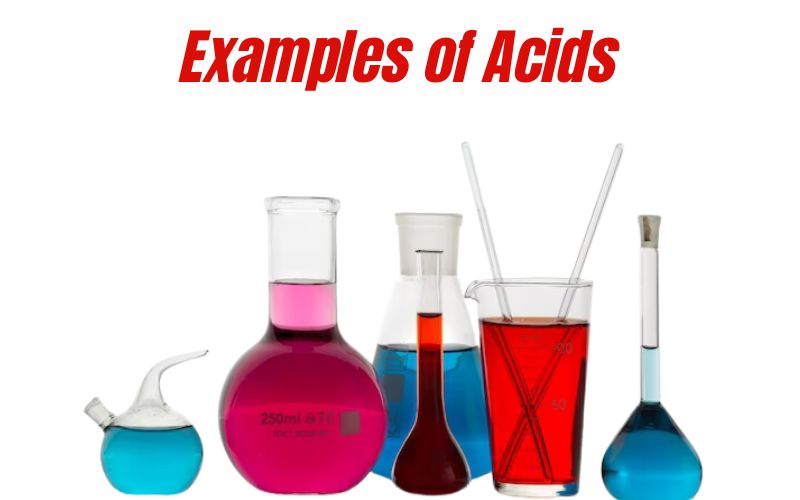Acids are a class of chemical substances that, when dissolved in water, release hydrogen ions (H⁺). These substances are characterized by their ability to donate protons or accept electron pairs in chemical reactions. Acids can be identified by their sour taste, ability to turn blue litmus paper red, and their capacity to react with bases to form salts and water.
Importance of Acids
- Biological Functions:
- Acids play crucial roles in biological systems. For example, the stomach produces hydrochloric acid to aid in the digestion of food.
- Industrial Processes:
- Acids are essential in various industrial applications, such as the production of fertilizers (phosphoric acid), textiles (sulfuric acid in dyeing), and plastics (acrylic acid in polymerization).
- Food and Beverage Industry:
- Acids contribute to the flavor profile of many foods and beverages. Citric acid, for instance, is found in citrus fruits and is commonly used as a food additive.
- Cleaning and Rust Removal:
- Many household cleaning products contain acids for their ability to dissolve minerals and stains. Hydrochloric acid is often used for rust removal in metal surfaces.
- Chemical Analysis:
- In analytical chemistry, acids are employed to determine the composition of substances. For instance, nitric acid is used to test for the presence of certain metals.
- Battery Technology:
- Lead-acid batteries, commonly used in automobiles, utilize sulfuric acid as an electrolyte for energy storage and release.
- Etching and Engraving:
- Acids like hydrofluoric and nitric acids are used in etching and engraving processes for metals and glass.
- Medical and Pharmaceutical Applications:
- Acids are employed in pharmaceuticals for drug synthesis and in medical procedures. Ascorbic acid (Vitamin C) is a vital nutrient for human health.
- Water Treatment:
- Sulfuric acid is used for pH adjustment in water treatment processes.
- Environmental Significance:
- Acids can have environmental impacts, as seen in acid rain, which results from the presence of sulfuric and nitric acids in the atmosphere.
- Polymerization and Plastics:
- Acrylic acid is used in the production of polymers and plastics, contributing to the vast array of materials we use daily.
In summary, acids play multifaceted roles in our lives, influencing both natural processes and human activities. Their significance spans various industries, scientific disciplines, and everyday applications, making them fundamental components of our modern world.
Also Read: Examples of Bases
Examples of Acids
Here are 100 Examples of Acids:
Common Acids
- Hydrochloric Acid (HCl)
- Sulfuric Acid (H₂SO₄)
- Nitric Acid (HNO₃)
- Acetic Acid (CH₃COOH)
- Phosphoric Acid (H₃PO₄)
- Citric Acid
- Tartaric Acid
- Malic Acid
- Oxalic Acid
- Formic Acid
- Benzoic Acid
- Carbonic Acid (H₂CO₃)
- Hydrofluoric Acid (HF)
Strong Mineral Acids
- Perchloric Acid (HClO₄)
- Chloric Acid (HClO₃)
- Bromic Acid (HBrO₃)
- Iodic Acid (HIO₃)
Weak Organic Acids
- Acetylsalicylic Acid (Aspirin)
- Lactic Acid
- Propionic Acid
- Butyric Acid
- Acrylic Acid
- Citric Acid
- Acetic Acid
Acids in Food
- Lemon Juice (contains citric acid)
- Vinegar (contains acetic acid)
- Orange Juice (contains citric acid)
- Tomatoes (contain citric acid)
- Apples (contain malic acid)
- Grapes (contain tartaric acid)
- Yogurt (contains lactic acid)
- Sauerkraut (contains lactic acid)
- Pineapples (contain citric acid)
- Cranberries (contain citric acid)
- Buttermilk (contains lactic acid)
Laboratory Acids
- Hydrobromic Acid (HBr)
- Hydroiodic Acid (HI)
- Selenic Acid (H₂SeO₄)
- Chromic Acid (H₂CrO₄)
- Hydrocyanic Acid (HCN)

Acids in Industry
- Sulfurous Acid (H₂SO₃)
- Phosphorous Acid (H₃PO₃)
- Boric Acid (H₃BO₃)
- Hydroxyacetic Acid (glycolic acid)
- Hydrofluosilicic Acid (H₂SiF₆)
Natural Acids
- Hyaluronic Acid
- Uric Acid
- Folic Acid
- Ascorbic Acid (Vitamin C)
- Cyanuric Acid
Uncommon Acids
- Peroxydisulfuric Acid (H₂S₂O₈)
- Fluoroantimonic Acid (HSbF₆)
Acids in Cleaning Products
- Sulfamic Acid
- Hydroxyacetic Acid (glycolic acid)
- Citric Acid (used in some detergents)
Acids in Medicine
- Acetylsalicylic Acid (Aspirin)
- Amino Acids (building blocks of proteins)
- Hydrochloric Acid (used in digestive processes)
Environmental Acids
- Acid Rain (resulting from sulfuric and nitric acids in the atmosphere)
- Fulvic Acid (found in soil and water)
Acids in Electronics
- Hydrofluoric Acid (used for etching glass and cleaning metals in electronics)
Acids in Cosmetics
- Kojic Acid (used in skin-lightening products)
- Hyaluronic Acid (used in skincare for hydration)
Acids in Photography
- Acetic Acid (used in developing photographic films)
Acids in the Food Industry
- Adipic Acid (used as a food additive)
- Phosphoric Acid (used in cola beverages)
- Malic Acid (used in sour candies)
Acids in Agriculture
- Hypochlorous Acid (used in agriculture as a disinfectant)
- Fulvic Acid (used as a soil conditioner)
Acids in the Human Body
- DNA Nucleic Acids (adenine, thymine, cytosine, guanine)
- Amino Acids (essential for protein synthesis)
- Lactic Acid (produced during muscle exertion)
Acids in Batteries
- Sulfuric Acid (used in lead-acid batteries)
Acids in the Oil Industry
- Naphthenic Acid (found in crude oil)
Acids in Materials Science
- Poly(acrylic acid) (used in superabsorbent polymers)
Acids in Bee Stings
- Formic Acid (found in ant and bee stings)
Acids in Wine
- Tartaric Acid (naturally occurring in grapes)
Acids in Astronomy
- Hydrogen Alpha Line (associated with emission of hydrogen-alpha spectral line)
Acids in Hair Care
- Citric Acid (used in some shampoos for pH balance)
Acids in Soaps
- Oleic Acid (found in olive oil, used in soap making)
Acids in Textiles
- Acetic Acid (used in dyeing and finishing textiles)
Acids in Paper Production
- Sulfurous Acid (used in paper pulping)
Acids in Preservation
- Benzoic Acid (used as a food preservative)
Acids in Inks
- Hydrochloric Acid (used in ink production)
Acids in Plastics
- Terephthalic Acid (used in the production of polyester)
Acids in Metal Cleaning
- Phosphoric Acid (used in metal cleaning and rust removal)
Acids in Gem Cleaning
- Hydrofluoric Acid (used in cleaning and polishing gems and glass)
Acids in Fireworks
- Nitric Acid (used in the production of certain fireworks)
Acids in Photography Fixing
- Acetic Acid (used in photographic fixing solutions)
Acids in Metal Etching
- Chromic Acid (used in metal etching)
Acids in Laboratory Analysis
- Perchloric Acid (used in analytical chemistry)
Acids in Water Treatment
- Sulfuric Acid (used for pH adjustment in water treatment)
Acids in Fertilizers
- Phosphoric Acid (used in the production of fertilizers)
Acids in Polymerization
- Acrylic Acid (used in the production of polymers)
Acids in Energy Storage
- Lead-acid batteries (utilizing sulfuric acid as an electrolyte)
Acids in Biological Processes
- DNA and RNA Nucleic Acids (essential for genetic information)
Acids in Cleaning Rust
- Hydrochloric Acid (used for rust removal in metal surfaces)
Acids in Dentistry
- Phosphoric Acid (used in dental etching for composite bonding)
Acids in Fishkeeping
- Tannic Acid (found in driftwood, used in fish tanks to mimic natural conditions)
Acids in Leather Tanning
- Tannic Acid (used in leather tanning)

